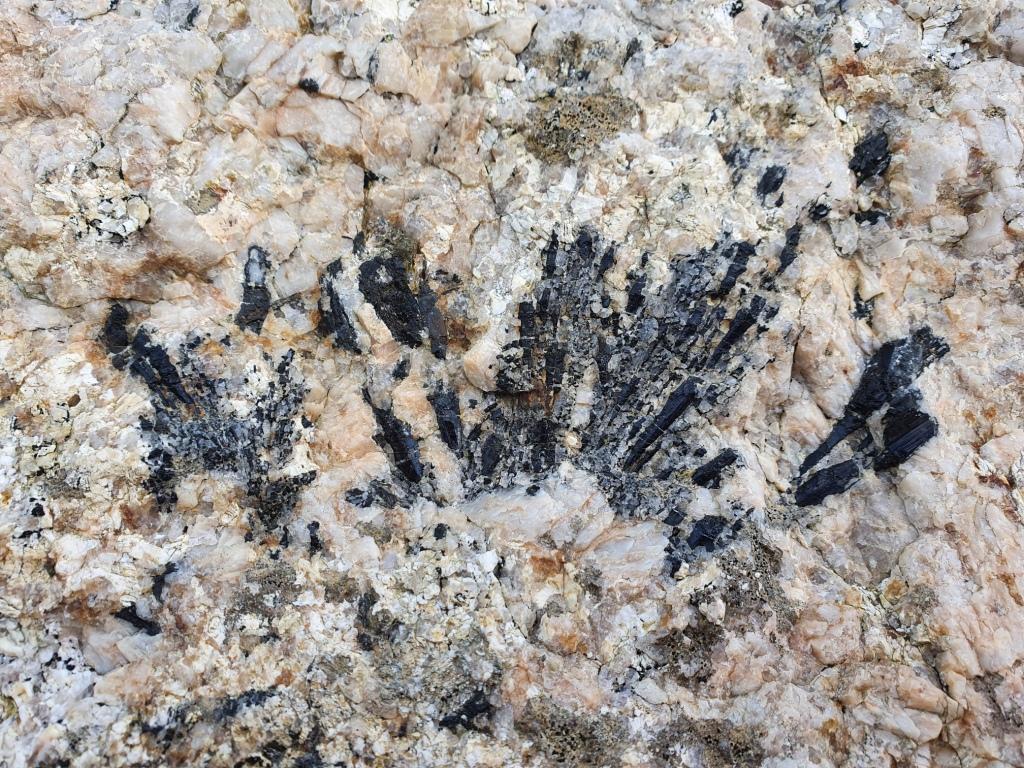Il s'agit d'une Earthcache, il n'y a pas de récipient à chercher.
Cristallisation de Tourmaline à Roscoff
A Roscoff on trouve de nombreuses occurrences de minéraux pegmatitiques-pneumatolytiques : tourmaline, béryls... Ces occurrences sont en relation avec l’évolution tardive du massif granitique du Plouescat-Roscoff.
Tourmaline
La tourmaline appartient au groupe de minéraux de la famille des silicates. Elle cristallise dans le système cristallin trigonal à réseau rhomboédrique en baguettes ou aiguilles allongées. Les tourmalines ont un éclat vitreux, les tourmalines ferrifères sont noires.
La tourmaline est un minéral pneumatolytique. Cela veut dire qu’elle cristallise au stade pneumatolytique de la cristallisation d’un magma. Ce stade correspond à la phase finale de la cristallisation d'un magma, à une température comprise entre 400 et 600°C environ ; la concentration des gaz H2O, HCl, CO2, H2S, etc., débouche sur la formation de minéraux particuliers tels que tourmaline, béryl, topaze, etc. que l'on appelle minéraux pneumatolytiques ou minéraux pneumatogènes, enrichis en éléments chimiques rares (B, Cl, F, Li, lanthanides, etc.).

Cristallisation
Selon les conditions de refroidissement du magma (vitesse, espace disponible, quantité de matière) les cristaux de tourmaline prennent des formes différentes. Souvent la zone médiane du filon de pegmatite (ou d’aplite) est enrichie en baguettes de tourmaline noire (A). Dans les murs anciens on peut voir la tourmaline en mouches (petits cristaux accumulés les uns sur les autres) dans le granite clair (C). Et enfin, la tourmaline noire peut cristalliser sur les plans de faille en forme d’oursins (B).

Minéraux automorphes ou xénomorphes
En observant la disposition des minéraux vous pourrez constater que certains minéraux sont automorphes: ils développent des faces cristallines qui leurs sont propres (A et B) ; alors que d'autres sont xénomorphes: ils remplissent les espaces laissés entre les cristaux automorphes (C) . Ceci est la conséquence de la chronologie des cristallisations.
Sources
Wikipedia
Une roche identitaire, Le Granite de l’île de Batz (Finistère)
https://www.geoportail.gouv.fr/donnees/cartes-geologiques
Michel, François ; Le tour de France d’un géologue, BRGM éditions, 2012
Questions pour valider cette Earthcache :
- Quelle occurrence de cristallisation de tourmaline trouvez-vous sous la zone rose de la Photo 1 ?
- Quelle est la différence entre des cristaux automorphes et xénomorphes ? Ici vous pouvez observer lesquelles ?
- Une photo de vous ou d’un objet vous représentant sur le site.

Loguez cette cache "Found it" et envoyez-moi vos propositions de réponses soit via mon profil, soit via la messagerie geocaching.com (Message Center), et je vous contacterai en cas de problème. Les logs enregistrés sans réponses seront supprimés.
English version
This is an Earthcache, there is no container to look for.
Crystallization of Tourmaline in Roscoff
In Roscoff there are many occurrences of pegmatitic-pneumatolytic minerals: tourmaline, beryls... These occurrences are related to the late evolution of the granite massif of Plouescat-Roscoff.
Tourmaline
Tourmaline belongs to the group of minerals of the silicate family. It crystallizes in the trigonal crystal system with a rhombohedral lattice in rods or elongated needles. Tourmalines have a glassy luster, iron tourmalines are black.
Tourmaline is a pneumatolytic mineral. This means that it crystallizes at the pneumatolytic stage of the crystallization of a magma. This stage corresponds to the final phase of the crystallization of a magma, at a temperature between approximately 400 and 600°C; the concentration of gases H2O, HCl, CO2, H2S, etc. leads to the formation of particular minerals such as tourmaline, beryl, topaz, etc. so-called pneumatolytic minerals or pneumatogenic minerals, enriched with rare chemical elements (B, Cl, F, Li, lanthanides, etc.).

Crystallization
Depending on the cooling conditions of the magma (speed, available space, amount of matter) tourmaline crystals take on different shapes. Often the middle zone of the pegmatite (or aplite) vein is enriched with rods of black tourmaline (A). In the old walls we can see the tourmaline in flies (small crystals accumulated on top of each other) in the light granite (C). And finally, black tourmaline can crystallize on sea urchin fault planes (B).

Automorphic or xenomorphic minerals
By observing the arrangement of the minerals you will be able to note that certain minerals are automorphic: they develop crystalline faces of their own (A and B); while others are xenomorphic: they fill in the spaces left between the automorphic crystals (C). This is the consequence of the chronology of the crystallizations.
Questions to validate this Earthcache:
1. What occurrence of tourmaline crystallization do you find under the pink area in Photo 1?
2. What is the difference between automorphic and xenomorphic crystals? Here you can see which ones?
3. A photo of you or an object representing you on the site.

Log this "Found it" cache and send me your suggested answers either via my profile or via geocaching.com (Message Center), and I will contact you in the event of a problem. Logs recorded without response will be deleted.